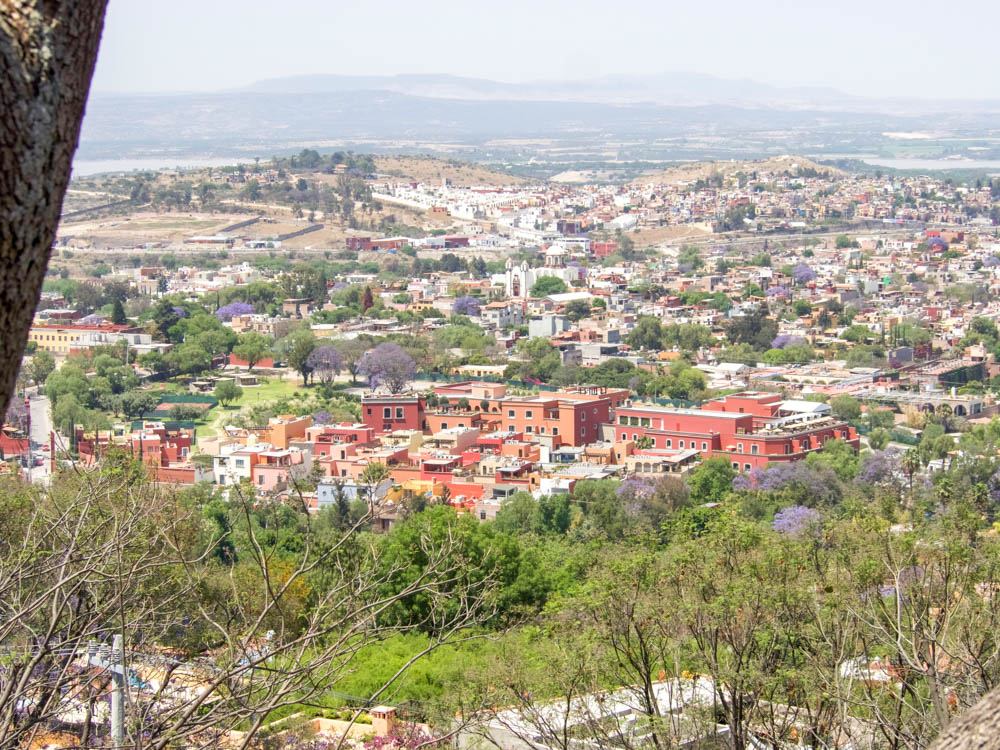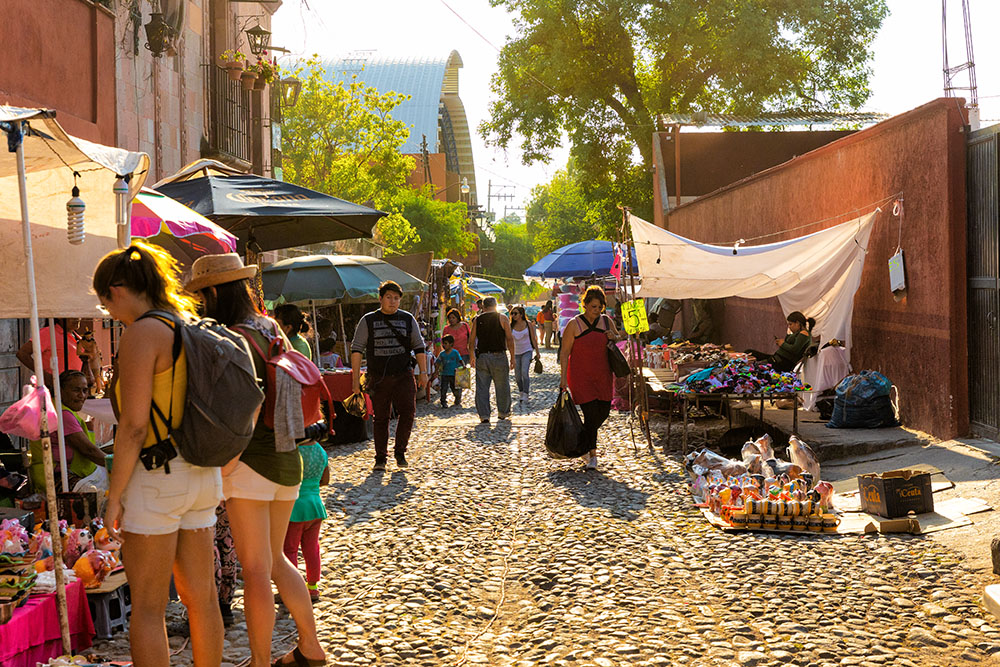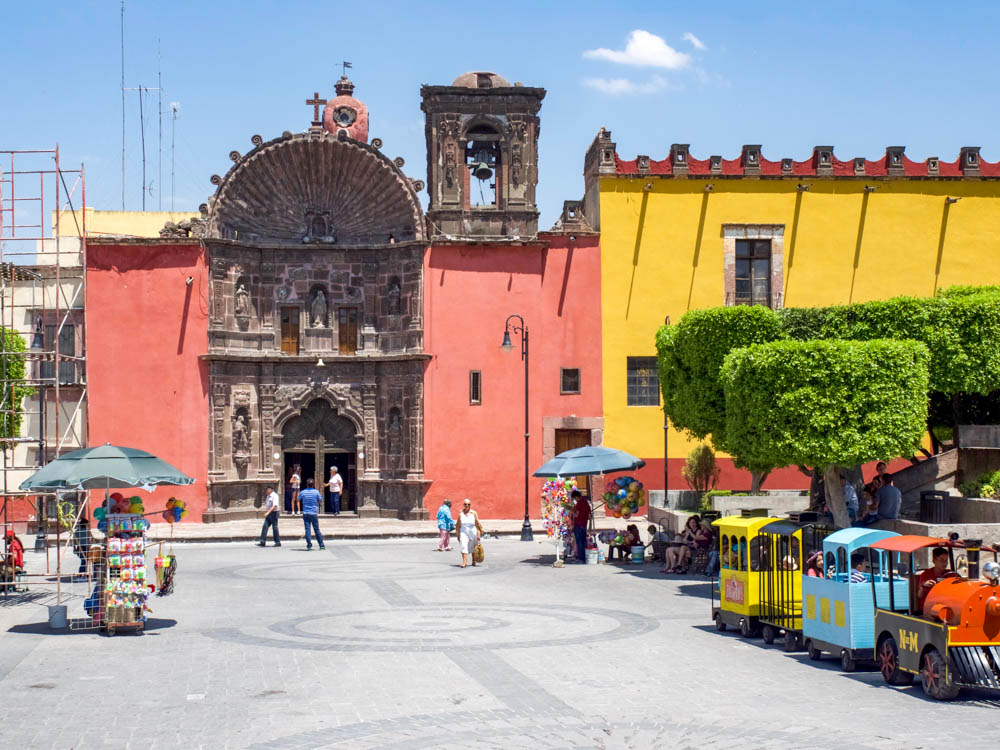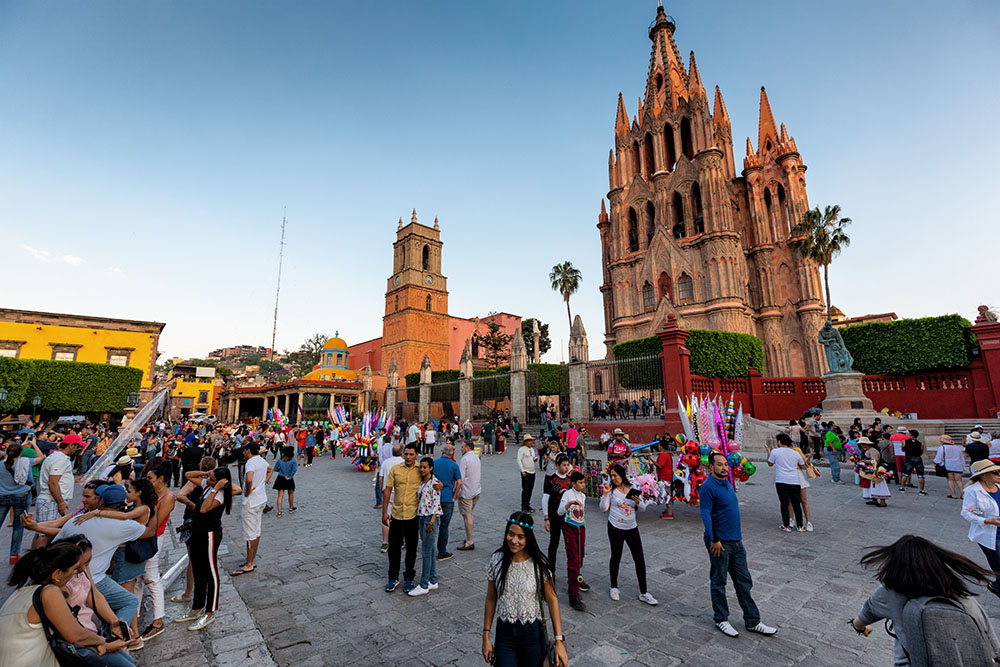Travel and Leisure named San Miguel de Allende, Guanajuato, Mexico the “best city in the world” in 2017, 2018, and again in 2021. It’s not difficult to see this quaint yet sprawling town’s appeal. San Miguel de Allende’s narrow streets invite travelers to explore every nook and cranny. Each unassuming alley leads to an undiscovered treasure.

There is a seemingly endless selection of restaurants and cafés and the city comes to life after dark. Evenings are filled with live music, rooftop cocktails, and giant paper-mâché mojigangas taking every opportunity to make tourists uncomfortable and bomb their photos. The landmark Parroquia de San Miguel Arcángel draws daily crowds eager to visit and photograph its famous pink facade.
My friend Tim originally wrote this article after our visit to San Miguel de Allende in 2018. He has since shut down his travel blog but I feel this is too important a topic to go unread. He has allowed me to republish it here on MWL to help give you a deeper look into this “charming” city before you solidify your travel plans.

Behind San Miguel de Allende’s charm
However, much like the neo-Gothic face they added to the front of the Parroquia 200 years after the original construction of the church, the city of San Miguel de Allende presents visitors with a charming facade that hides the true nature of life in the city.
(As Ashley says in her post on San Miguel de Allende travel tips, “Travel and Leisure readers voting San Miguel de Allende the “world’s best city” tells me everything I need to know about Travel and Leisure readers.”)

Visiting San Miguel de Allende: a visitor’s perspective
San Miguel de Allende’s many glowing reviews drew me to this city. Eager to experience the charming city streets at sunset, I headed to one of its many famous rooftop bar/restaurants. The city certainly didn’t disappoint in that respect. The endearing streets dazzle visitors with their walls of colorful buildings and hidden courtyards. Magical sunsets light up the streets and buildings in a sort of indescribable neon pastel glow.
My Airbnb host, an American expat, was eager to describe the vast activity options this city has to offer. She enthusiastically tipped me off about organic farmers markets, cafes galore, art galleries, wine tasting, spas and upscale dining.

Although I appreciated her efforts, I was really more interested in the local experience not the city’s many luxury offerings. As it turns out, those options really do reflect the local experience these days.
New York Magazine’s Love Note to San Miguel de Allende is a perfect example of everything that is wrong with the direction the city is going. The author simultaneously waxes poetic about the city’s simple pleasures while recommending hotels that start at $340 per night and “wellness-centered cooking courses” taught by an expat, because of course.
Don’t get me wrong, I can absolutely appreciate splurging on travel. However, these things go against what is at the heart of San Miguel de Allende – the local people who have made it what it is today.
If you’re planning to visit San Miguel de Allende for Día de los Muertos, be sure to check out my post on celebrating Day of the Dead in Mexico as a foreigner.

Don’t expect the small village experience
I’m an unapologetic sucker for quaint villages that have an authentic, local feel to them and expected the same of San Miguel de Allende. While it certainly has its local flair, the city also felt like a downright tourist trap.
With tourism being the number one industry in San Miguel de Allende, I can hardly fault them for catering to visitors, but there is a distinct difference between experiencing what life is actually like there and seeing cultural demonstrations that are manufactured for tourists to feel like they’re seeing a different culture.

The city’s central Jardín Allende (apparently referred to as “Gringo Gulch” by the locals) explodes with activity at all hours of the day, but it’s not the romanticized notion of locals who can’t help but express their culture. It’s mariachi bands singing for tips, giant mojigangas gleefully posing with photos with tourists and hat vendors wading through the crowds of tourists and expats to make a living. Does this sound like typical daily life or a mini Mexican Disneyland featuring culture porn for tourists’ consumption?
Honestly, Mexico City feels way less manufactured and real than it does here. Consider CDMX instead and check out these 15 incredible Mexico City experiences when you get there.


Beyond that, San Miguel de Allende is a crowded city. During the day, vehicles choke the narrow streets. Come nighttime, the Jardin is bustling with people. This is great and all, unless you’re trying to get a shot of the sunset. In this case, it becomes a competitive sport.


San Miguel de Allende’s history of cultural imperialism and foreign gentrification
The issues prevalent in San Miguel de Allende aren’t a new problem to the city. In fact, beyond the Spanish conquest of the Aztecs that pervaded all of Mexico, this city was an early poster child for the Europeanization of Mexico.
San Miguel de Allende is literally named after the Franciscan friar who prolifically converted natives to Christianity. This city was founded on the principles of converting local cultures to fit foreign standards.
This attitude has been pervasive throughout its entire history and continues to be a dominant theme of the city today. Even the city’s signature landmark, the Parroquia de San Miguel Arcángel, features an updated European design plastered over the front 30 feet of the original church.

Likewise, during the reign of Mexican president Porfirio Díaz known widely as the Porfiriato, he (a Francophile) ordered the reconstruction of many cities in the French style—including San Miguel’s central Jardín Allende. It features iron benches and decoratively trimmed trees that stand to his day.



We can trace the current influx of white expats back to 1938 when American artist Stirling Dickinson established an art institute here. This institute subsequently attracted more American artists after World War II who were able to study abroad under the GI Bill.
San Miguel de Allende’s reputation as a cultural hub quickly solidified and remains to this day. This is not to say that Mr. Dickinson failed to help locals as well (he actually quite disliked the influx of Americans to the city – seriously, read that article, it’s fantastic), but he certainly set the tone for the future of San Miguel de Allende.

San Miguel de Allende and the expat impact
The city of San Miguel de Allende’s population currently stands at around 60,000 people (and roughly 175,000 in the greater municipality), with about 10,000 of that number consisting of expats.
Just look at this CNN article featuring expat life in San Miguel de Allende, with the youngest interviewee being 52 years old. I found this to be largely representative of the expat demographics in the city as well. I don’t have any problem with expat living, but when almost 20% of a Mexican city’s population consists of older, well-to-do white people, there will inevitably be an impact on the local population.

This impact is most easily measured in the price of rent and real estate. The average house price is $540,000 USD in the city and the income to rent ratio makes San Miguel de Allende more unaffordable than San Francisco!
One of my travel companions summed the culmination of these statistics best. After paying $3 USD for a 30-minute taxi ride, she exclaimed “how does anyone afford to live here?” I had difficulty figuring that out for myself and I still don’t think I know the answer.


Poverty remains a big problem in San Miguel de Allende
The issue of income inequality in San Miguel de Allende is not as simple as rich expats versus struggling locals. Some of the statistics about the city’s demographics, however, shocked me. For starters, 48.56% of the population of the “best city in the world” is in “moderate” or “extreme” poverty.
Here are some of the other 2020 statistics concerning San Miguel de Allende:
- 63% of the population over the age of 15 has only a middle school education or less
- 8% of residents do not have access to sewage systems (that’s 14,400 people without a toilet)
- 11.42% of homes do not have access to healthcare (2015 CONEVAL report)
- 14.72% of homes do not have a refrigerator
- 8% illiteracy rate in people over the age of 15

Additionally, CONEVAL* named San Miguel de Allende as having the highest level of income inequality in all of Mexico. *(The National Council for the Evaluation of Social Development Policy)
One nuance of these statistics to consider is that these numbers are for the municipality and not the city alone. However, seeing them still shocked me. San Miguel de Allende trails behind the rest of the state in nearly every category besides access to health services.

What is being done?
As shocking as these statistics may be, they actually represent huge strides in improvements over the last several years. There are a number of great charities working with the local population to provide healthcare and education to locals. Also, the Mexical Social Infrastructure Fund (FAIS) has been making significant strides with providing people with access to basic services.
Many of the local expat-run activities actively donate their proceeds to charity. This is simultaneously encouraging and somewhat ironic. The people partially responsible for driving up housing prices are making some effort to improve the lives of impoverished locals.

What can I do as a tourist to San Miguel de Allende?
First of all, don’t retire and move to San Miguel de Allende and buy an expensive house! On the other side of the coin, however, don’t avoid visiting the city just because of its issues.
All of San Miguel de Allende’s population relies heavily on tourism. Skipping your visit would exacerbate the problems it already faces. However, there are some great ways to support locals on your visit to San Miguel de Allende.

Skip the fancy stuff & support local businesses
Instead of the corporate-owned luxury hotel, find a locally (non-expat) owned rental home or boutique hotel. You can view host profiles to get a rough idea of whether you’re supporting a local resident or contributing to another real estate empire.
In a similar vein, try and seek out locally owned restaurants and avoid dining in hotels. Ask around and see what most people recommend; it’s a better way to dine anyways. And don’t skip the street food!
Where to stay in San Miguel de Allende
Check out these locally owned (non-expat) vacation rentals in San Miguel de Allende and some booking tips below:
Divino Depto (Divine Apartment)
2 bedrooms, 2 bathrooms, fully equipped kitchen, and a beautiful patio with lake views. Large, colorful, modern, and pet-friendly!
Casa de Aduende
Whole house, 4 bedrooms that can sleep up to 10 people. Tons of space in a cool property!
Casa de los Ángeles
3 bedroom house for up to 5 adults (or 7 if there are 2 kids). Listed as a Travel Sustainable Property.
Casa Rosario
Whole house, 5 minute walk to the center, big terrace with amazing views. Says 1 bedroom but I count at least three. Also says sleeps 10? Either way, this place is beautiful!
A few tips when searching for locally-owned properties:
- Always read host profiles – this will give you a good idea as to the kind of business you’re supporting. Trust me, they’ll talk allll about how they fell in love with San Miguel de Allende but still live in Los Angeles/San Francisco/Dallas, etc. for most of the year.
- If there isn’t a host profile, stay away. The other side of that is that they just don’t want you to know who you’re supporting.
- If you check out a lot of different rental options and you notice they all have identical/similar profiles, that’s a sign you’re contributing to an expat’s real estate empire.
- Bonus points if the listing is 100% in Spanish and they don’t list English as one of their “languages spoken.”
- If the owner’s phone number starts with +1, there’s a good chance it’s expat-owned and run from the U.S.
- It’s much harder to find locally-owned properties on Airbnb as that’s an expat’s dream platform. Also, you won’t find any on VRBO either because of a new tax structure the state imposed on them. However, I’ve found a lot more by filtering specifically for “vacation homes” in San Miguel de Allende on Booking.com. (Check the “vacation homes” box on the left side of the page.)

Support San Miguel de Allende’s charitable activities
Again, many of the expat-run activities in San Miguel de Allende donate all of their proceeds to charity. Some of the options include:
- The wonderfully quirky Mask Museum, which donates all of its proceeds to Centro Infantil de los Ángeles.
- The informative Historical Walking Tour, which is run by Patronato Pro Niños. I got much of the info in this post from what I learned on this tour! Disclaimer: my group was the youngest on the tour by about a 30 year margin.
- Attend an event from Feed The Hungry SMA, or contact them if you’re a blogger because they love to work with us to help bring awareness to their cause!
- Or take this fascinating walking tour of San Miguel de Allende. This is not a charitable activity but it is one of the very few that is run by native of the city. (And reviewers love it!)

Buy local souvenirs
I was critical earlier about the hat vendor roaming the Jardin in an attempt to make a living. However, while the touristy aspect does make San Miguel de Allende less appealing to me as a whole, these people need the help of travelers.
Buy your souvenirs from local vendors who clearly have stake in the game. Skip the high end art gallery and buy a painting from a street vendor. And while you’re at it grab one of those hats because it’s Mexico and it’s always sunny! Don’t forget to check out the local flea markets as well for just about any of your needs.

Avoid contributing to crime: don’t give handouts
As much as it hurts to walk past suffering people on the street, giving to beggars reinforces horrific practices like organized crime, human trafficking, and child mutilation that will continue for as long as they get money from tourists.
Need help getting around in Mexico? The ADO bus system is fantastic… if you can figure out how to buy tickets. If you’re having trouble, check out this guide to Mexico’s ADO bus system.

San Miguel de Allende wasn’t for me, but it might be for you
San Miguel de Allende wasn’t my kind of destination. I’d much rather spend my time in Mexico City, which I completely fell in love with.
At the same time, I can’t let the gentrification of San Miguel de Allende stop me from telling you to visit. Just be aware that it is not exactly a city for the young, adventure-loving traveler.
The vast majority of people I’ve spoken to have loved their visits to this charming city. However, my group of friends all found it quite overrated.


If you’re considering a visit, take my experiences into account but by all means don’t let it stop you from strolling the cobblestone streets and taking in the rooftop views. All I ask is that you skip the luxury spa and don’t spend a million dollars on a house there.
Share this info, pin this image:








 The Free Florida Toll Pass for Visitors: How to Get It + What You Need to Know
The Free Florida Toll Pass for Visitors: How to Get It + What You Need to Know






